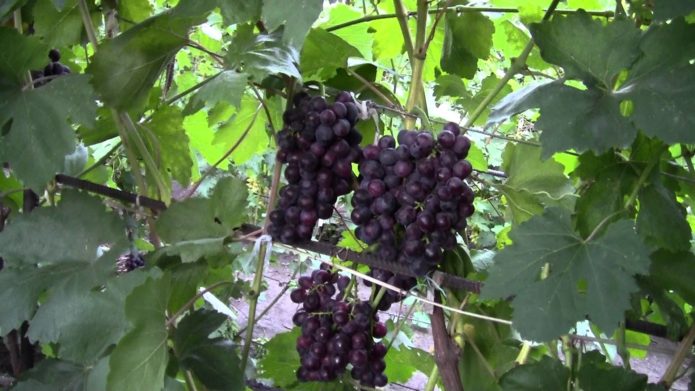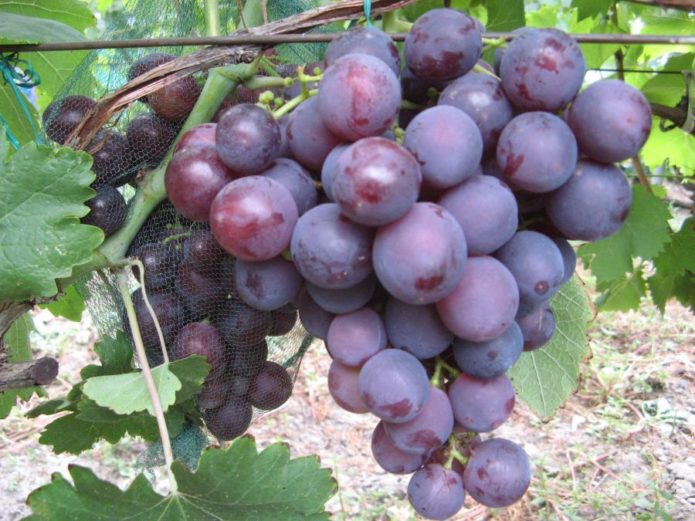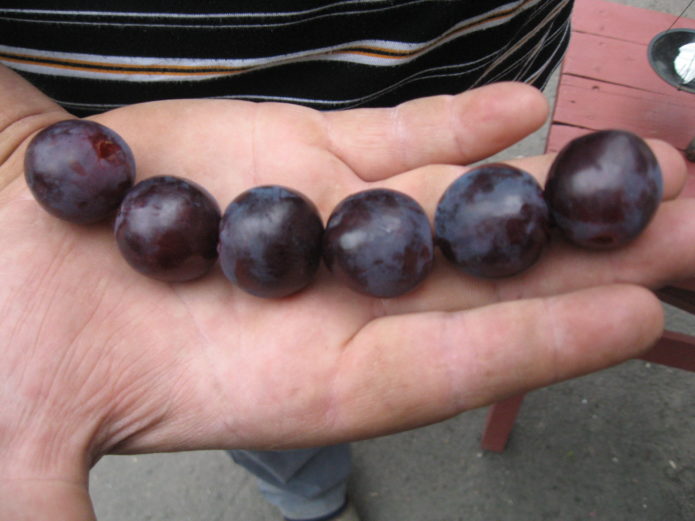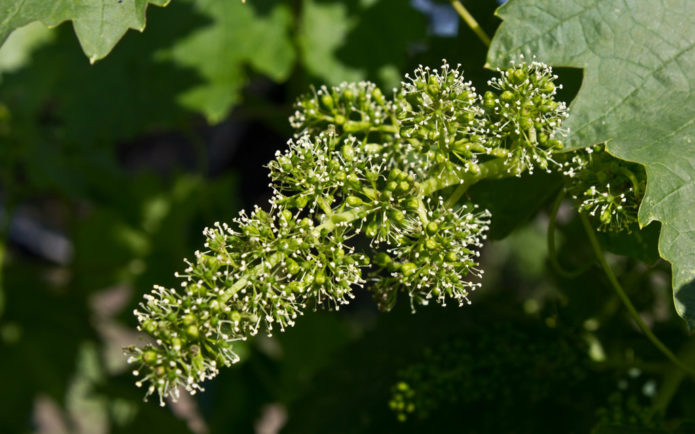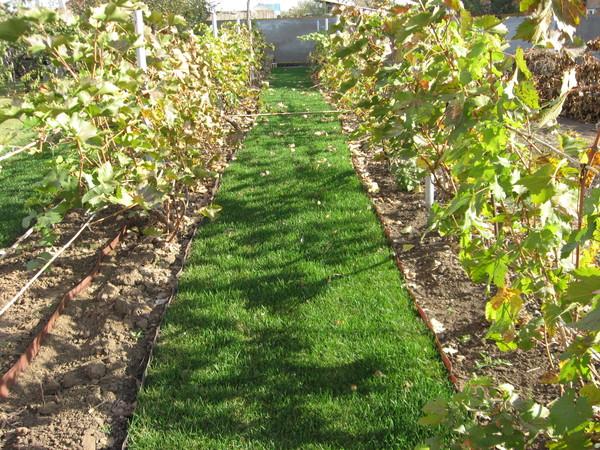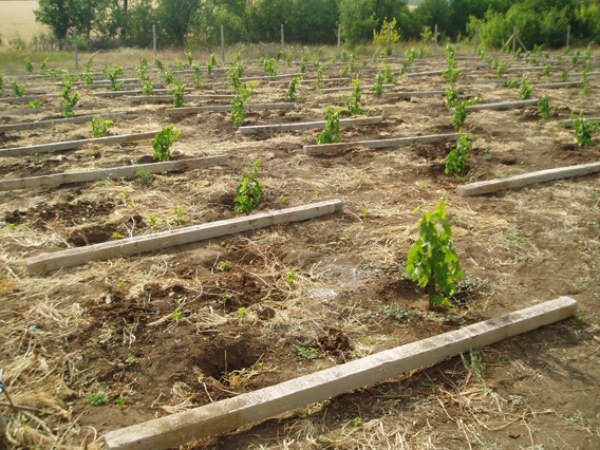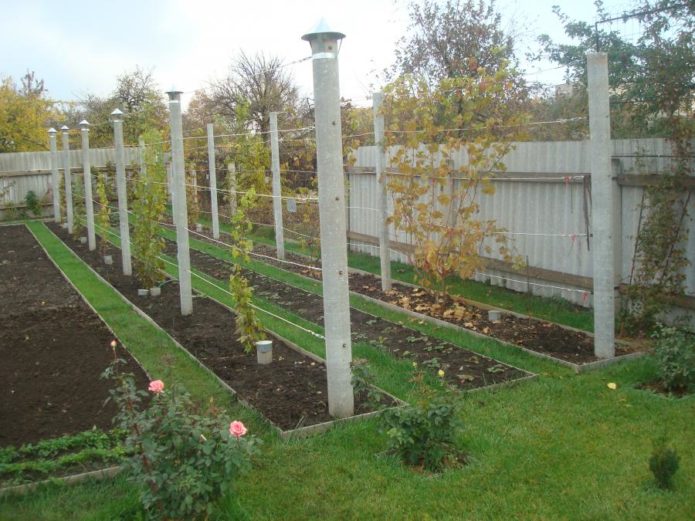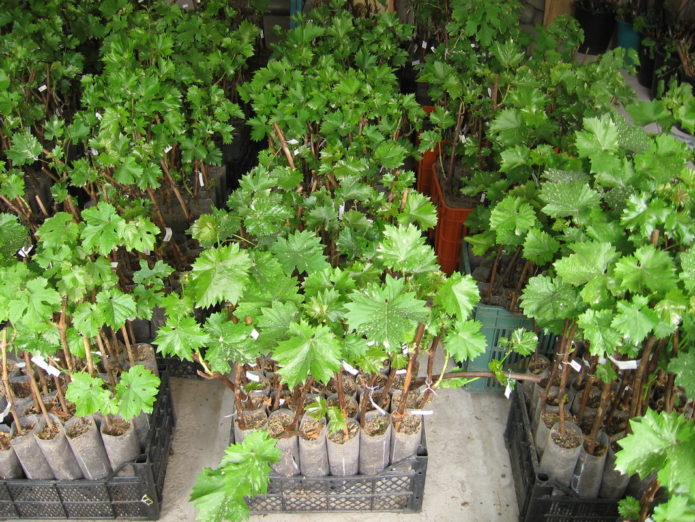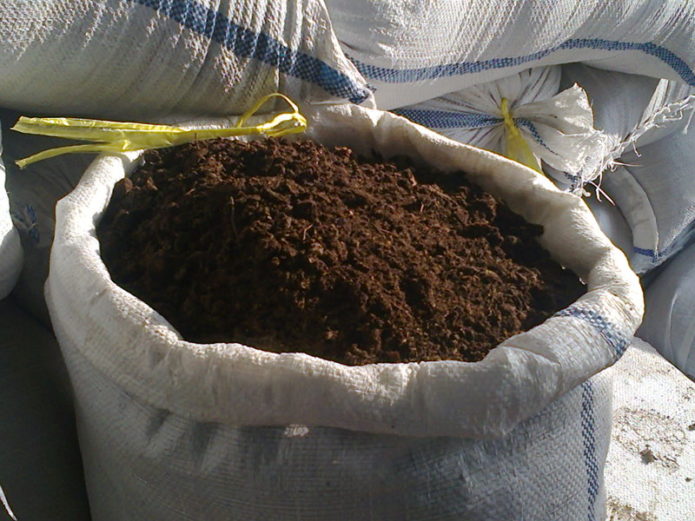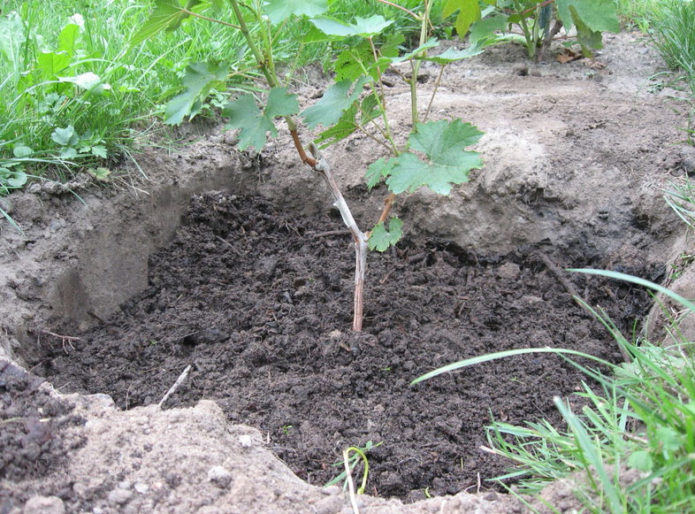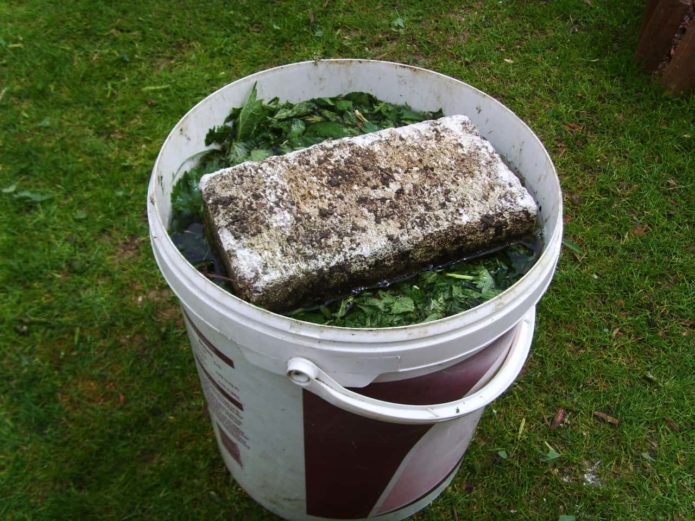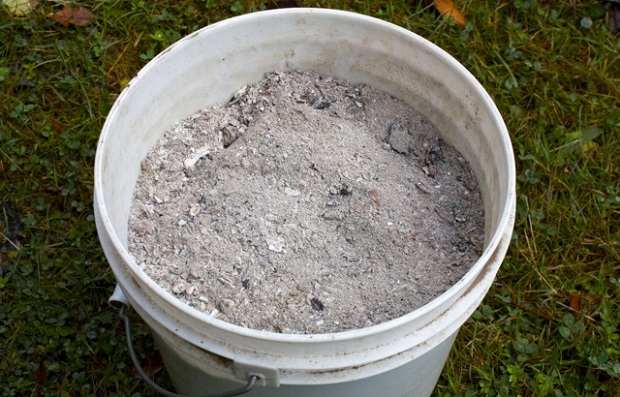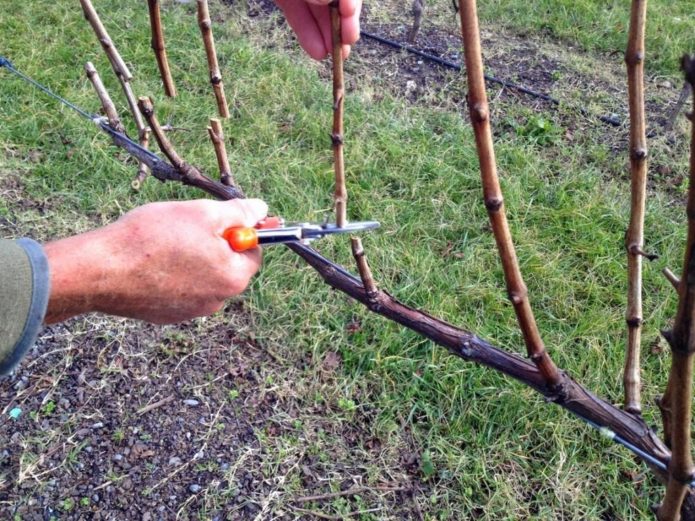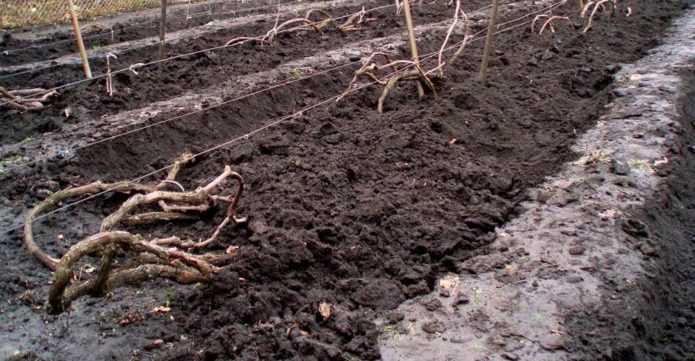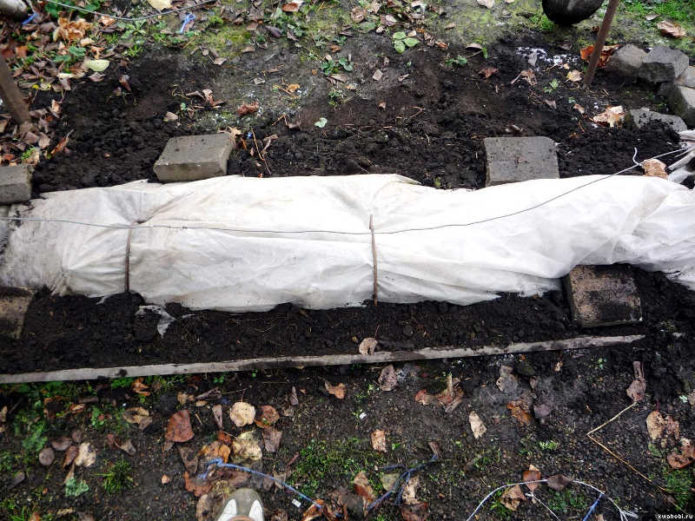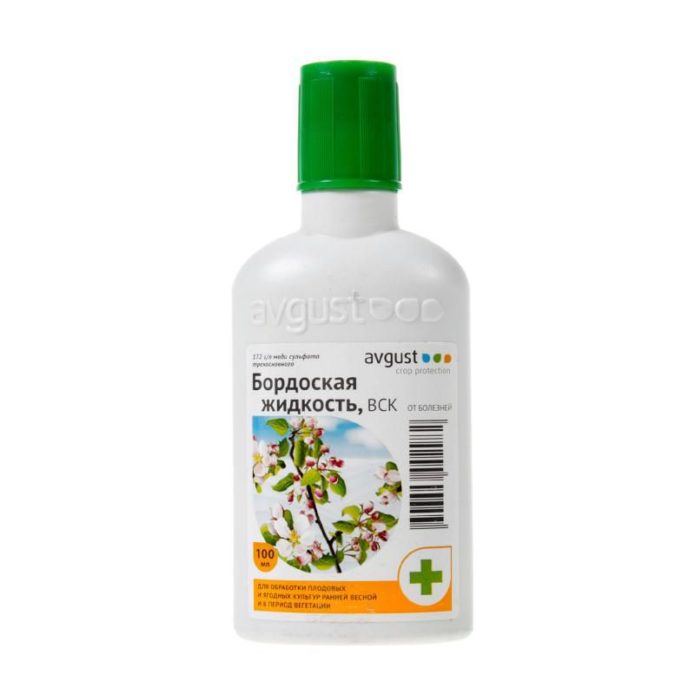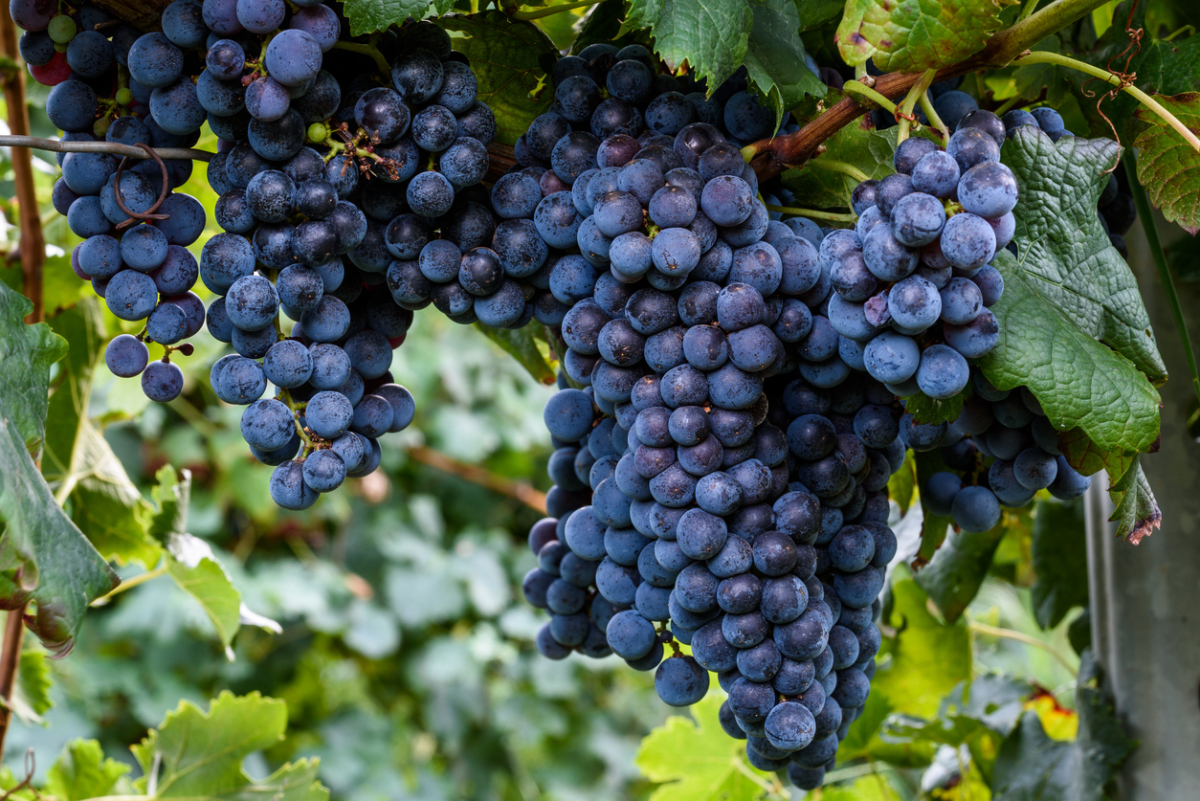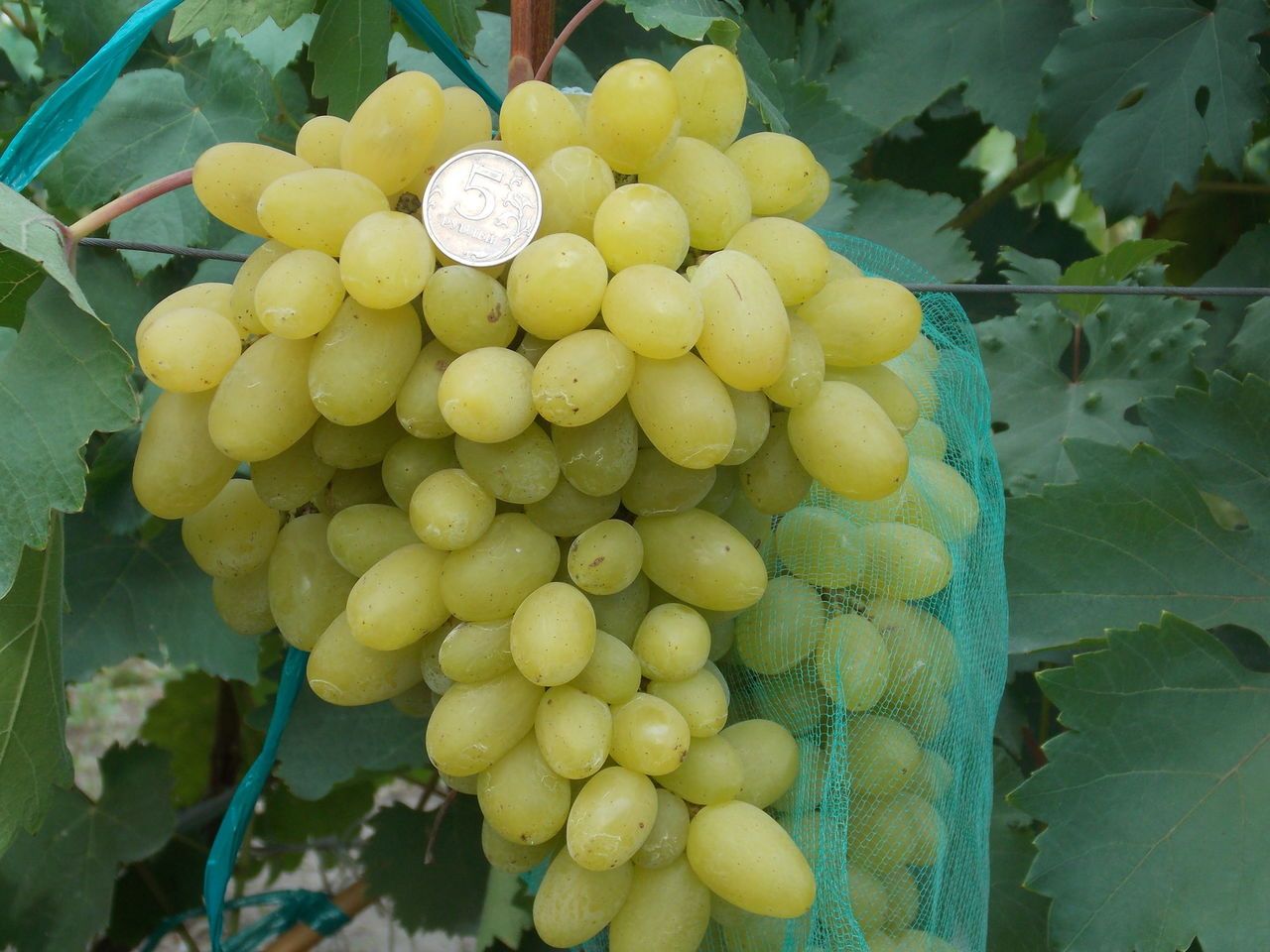More and more gardeners are interested in viticulture, because breeders have already bred many varieties that successfully adapt to the conditions of a climate unusual for a culture and bring a very good harvest. Rochefort is not an achievement of a professional, but of an amateur, but by many criteria it is considered almost a standard. And unpretentiousness in care makes the variety very suitable for a not too experienced gardener who wants to experiment and try to grow something new.
Content
What Rochefort grapes look like
Rochefort is a relatively new but already very popular grape variety. A very successful selection achievement belongs not to a professional, but to an amateur - E. G. Pavlovsky. The "parents" of the new variety are the Talisman variety and the popular cardinal nutmeg grape... Rochefort belongs to the category of table varieties, is valued for its undemanding care and early ripening. It was withdrawn in 2002. From the "ancestors" he inherited large-fruited and characteristic taste, but compares favorably with them in terms of resistance to diseases typical of the culture.

Rochefort grapes appeared on the market relatively recently, but has already managed to find many fans.
In appearance, the grapes are considered almost standard. The berries are very large, painted in a rich dark color. The brushes are of the correct shape, dense. The percentage of small grapes and unmarketable berries tends to zero.
Rochefort is very vigorous. The wood ripens well. The average annual growth is about 135 cm. The shoots are densely leafy. The harvest ripens quickly, from the time of flowering only 110–120 days pass, and if you are especially lucky with the summer weather, even less. As a rule, the bunches can be cut in the second decade of August.
The brushes are regular, conical, dense. The average weight of one bunch reaches 0.5–1 kg. But with proper care, they increase in size and gain weight of 3-4 kg. The vine is able to handle such a load. Even perfectly ripe berries do not fall off and do not rot; they remain on the branches for a long time without losing their presentability. The taste does not suffer either. 12-22 clusters are formed on each vine, but this is too many, it cannot “feed” such a number of fruits. Therefore, it is imperative to ration the harvest.
The berries are almost spherical or slightly elongated. The skin is painted in a very dark blue-violet color with a red-burgundy undertone. From a distance, the grapes appear almost black. Average weight - 8–15 g, somewhat less often - 18–20 g. Length - 2.6–2.8 cm. The size of the berries is comparable to a five-ruble coin. Rochefort inherited a light nutmeg aroma from the Cardinal variety. The same notes are present in the aftertaste. Thanks to this feature, it is highly appreciated by lovers of home winemaking.
The pulp is very fleshy, juicy, tender, and at the same time "crispy". The skin is firm but thin. Thanks to her, Rochefort is well stored and can be transported over long distances. The average sugar content is 14–18%; berries accumulate sweetness rather quickly. But you can't call them cloying either. Due to the light refreshing acidity (fruit acid content - 4–7%), Rochefort has a very balanced taste. Each berry contains 3-4 large seeds.
Rochefort's berries acquire the typical shade of the variety before they are fully ripe. Take your time to cut the brushes, you need to focus not only on the color of the skin, but also on the taste and sweetness of the berries.
The yield of Rochefort cannot be called outstanding (an average of 4–6 kg per vine, if you are very lucky with the weather in spring and summer - 8–10 kg), but it more than pays off for its amazing taste. Frost resistance is quite sufficient to survive the winter in subtropical regions without shelter (up to -21-23 ° C), but in the Urals, Siberia, in central Russia, it is better to play it safe and take care of the protection of vines in the fall. When determining a site for a vineyard, it should be borne in mind that this culture has a negative attitude towards cold drafts.
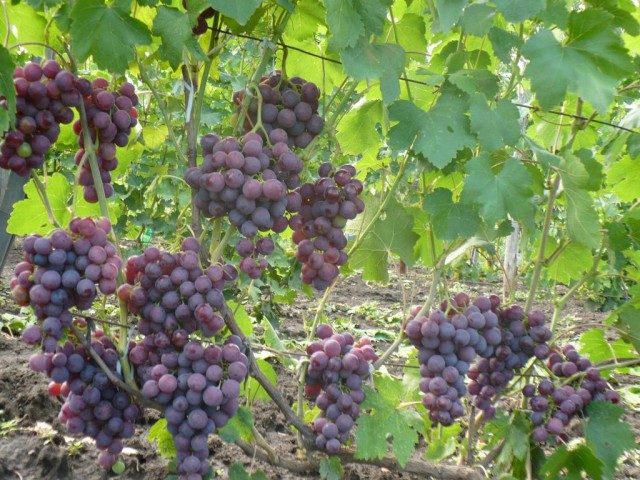
The Rochefort grape variety "works" not for quantity, but for quality - it cannot be called over-yielding, but the berries are beyond praise
Rochefort rarely suffers from such a dangerous fungal disease for grapes as mildew (resistance is even higher than the declared 3-3.5 points). The creator claims that he also resists powdery mildew well (2.5–3 points), but the cultivation experience, albeit not too rich so far, shows that this is not entirely true. The most potentially dangerous pest for this grape variety is phylloxera. Prevention and control will have to be given special attention. Wasps and birds do not pay special attention to these grapes. The first is hindered by the dense skin, the second is not too tasty with a characteristic aroma.
How to protect grapes from pests and diseases:https://flowers.bigbadmole.com/en/yagody/vinograd/obrabotka-vinograda-osenyu.html
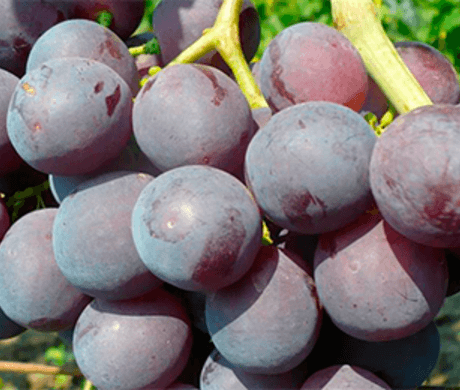
Rochefort berries look just amazing, even if other varieties are grown on the site, the look immediately stops on them
With the reproduction of Rochefort, difficulties most often arise. Both seedlings and cuttings successfully and quickly adapt to new living conditions. The variety belongs to the category of self-pollinated, accordingly, the gardener does not depend on bees, bumblebees and other insects, which often do not show activity in spring when it is issued damp and cool. It can also be used as a pollinator for other grape varieties.
By the way, Rochefort blooms quite late. It is a very valuable quality for those who want to grow it in temperate climates. Thus, the risk of damage to buds by recurrent spring frosts is minimized.
Some gardeners, as a disadvantage of this variety, note the tendency to pea berries. Indeed, it happens sometimes, but not too often. The vine has "bad" seasons, it is impossible to predict them in advance. But proper crop care will help minimize the risk of crumbling berries.
Video: description of Rochefort grapes
Planting Rochefort seedlings and the necessary preparatory procedures
Rochefort's general unpretentiousness extends to growing conditions. But if you want to get a good harvest on a regular basis, you need to be wise when choosing a place for a vineyard and prepare a planting pit with high quality. Another important point is the choice of seedlings.
Like any grape variety, Rochefort loves warmth and bright sun. Accordingly, an open place is selected for disembarkation. Ideal for a vineyard is a plot closer to the top of a gentle hill, the slope of which is oriented to the southeast or southwest. At the same time, the vine does not react well to gusts of cold wind and drafts. It is advisable to protect the plantings from the north with a natural or man-made barrier. It should be located at some distance from the vineyard, without shading the vines. The best option is a stone or brick wall, a concrete fence, and so on. These materials heat up during the day, and at night they share the accumulated heat with the grapes.
Preparing a place for grapes, planting depth and scheme, fertilization and proper watering:https://flowers.bigbadmole.com/en/yagody/vinograd/kak-posadit-vinograd-vesnoy-sazhentsami.html
Rochefort is generally indifferent to the quality of the soil, but practice shows that in light sandy soil the vine develops more slowly and, accordingly, bears less fruit. In general, any grape loves gravelly but fertile soil.
What he categorically does not tolerate is stagnation of water at the roots. They go deep into the soil, 5–6 m. Therefore, if the groundwater is located closer than 2–2.5 m from the surface of the earth, it is better to find another place. In the absence of an alternative, high ridges (0.6 m or more) are built. By the same criterion, any lowlands are excluded. After all, there is rain and melt water for a long time, damp chilly air accumulates.
The time for planting grapes in a permanent place depends on the climatic conditions in the growing region. In the warm subtropics, the gardener can focus solely on his own preferences. The procedure can be carried out both in autumn (from the beginning of September to the end of the first decade of October) and in the spring. Even if you choose the first option, the plant will have time to "get used" to the new place and accumulate enough nutrients for wintering.
Spring disembarkation is the only possible option for regions with a temperate climate. Winter is extremely rare there, or rather, almost never comes in accordance with the calendar. It is absolutely impossible to guess how much time is left before the first frost.
Each vine needs ample feeding area. Otherwise, the roots of the grapes begin to "creep" to the sides and "strangle" even fruit trees and berry bushes located at a considerable distance from them (10-15 m). At least 2.5 m is left between the seedlings of Rochefort, the rows of vines are pushed apart from each other by 2.5–3 m. By developing grape planting scheme, it is necessary to allocate space for the trellis. The simplest option is several supports dug into the soil with a wire stretched over them in three rows. The lower one is located 40-60 cm from the surface of the earth, the next one is 100-120 cm, the last one is 150-180 cm. As the vines grow, they are tied to a support. So that they do not fray, they put a layer - a washcloth or other soft material.
Rochefort grapes take up a lot of space on the site. You can significantly save space by planting garden strawberries, radishes, early cabbage varieties, onions, garlic, carrots, beets, and herbs in the aisles. The root system of all these crops is superficial; they are not “competitors” of grapes in terms of nutrition. Any siderata, marigolds, calendula, lavender, sage are also suitable. Practice shows that pungent odors scare away many pests from the beds. Peppers, tomatoes and horseradish are unwanted neighbors for Rochefort. These plants strongly oppress the vines.
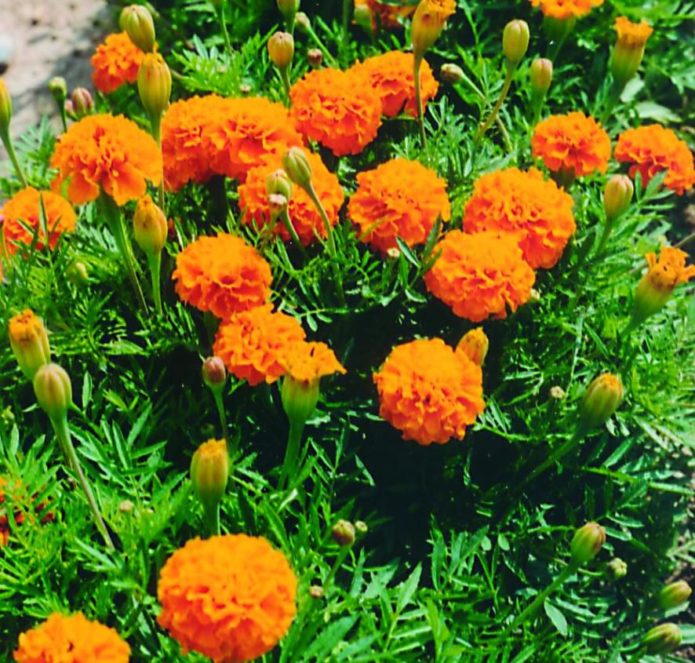
Marigolds next to grapes are not only beautiful, but also useful, their pungent smell repels many pests
The choice of a seedling must be approached very responsibly, because this is, in fact, your future harvest.They purchase planting material exclusively from trusted, reliable suppliers. Otherwise, a gardener, especially a beginner, having bought grapes of the desired variety at the fair or from hands, may be very unpleasantly surprised. Ask in advance about the location of the nursery where the seedlings are grown. If it is located close to the growing region or to the north, you can expect that the acquired plants will take root faster, because they are already familiar with the conditions of the local climate.
As follows from the experience of winegrowers, seedlings at the age of two years show the best survival rate. They must have a developed root system of two "nodes" (upper and lower) and several side shoots. The roots of "correct" specimens are flexible, elastic, creamy white on the cut. The bark is smooth, one shade, not flaky and without spots suspiciously reminiscent of mold and rot. There must be a small "influx" on the trunk - the place of inoculation. If not, the seedling is grown from seed. It can almost certainly be argued that he did not inherit the varietal characteristics of the "parent".
The planting hole is dug in the fall. If disembarkation is planned for this time of year - at least 2-3 weeks before the proposed procedure. The optimum depth is 85–90 cm, the diameter is 70–75 cm. Drainage is poured at the bottom, creating a layer of about 10 cm. Suitable material - pebbles, expanded clay, crushed stone, clay shards. They immediately take care of watering the plants. To do this, a plastic pipe with a diameter of about 8-10 cm is stuck into the substrate at the bottom. It should rise 6-10 cm above the soil level.
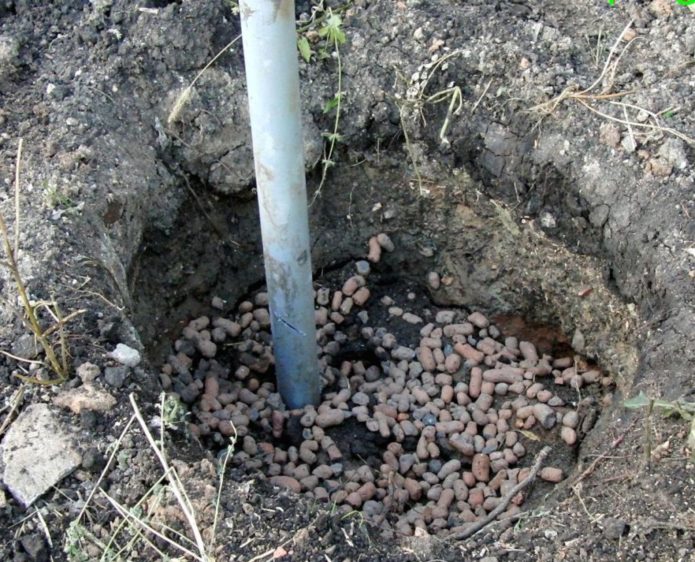
At the bottom of the planting pit for a grape seedling, a drainage layer is required - this will prevent water from stagnating at the roots
Then 30-40 liters of humus or compost is poured into the pit. If the substrate is heavy, clayey, add another 5-7 liters of sand. Then comes a layer of fertile turf of about the same thickness, mixed with fertilizers (150-190 g of simple superphosphate, 110-130 g of potassium nitrate, 250-300 g of dolomite flour). Gardeners who are not too fond of mineral fertilizing can replace them with wood ash (about 2 liters). The substrate in the pit is well spilled with water. When it settles, about 10 cm of humus is added from above and covered with slate, roofing felt, and other material that does not allow water to pass through. About 40 cm should remain to the upper edge. In this form, the pit remains until spring.
The most suitable time for the Rochefort landing is from the end of April to the beginning of the third decade of May. The substrate should warm up to at least 10–12 ° C at 10 cm in depth. In this, you can focus on the beginning of the flowering of dandelions. You need to be in time before the seedling "wakes up" (when the leaf buds have blossomed, it is already too late).
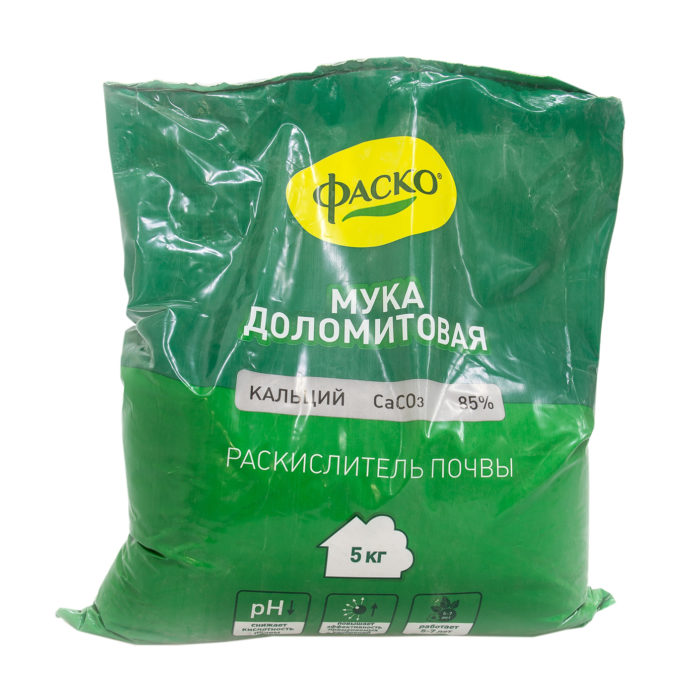
Dolomite flour is a natural soil deoxidizer, if you do not exceed the dosage, it has no side effects
The direct procedure for planting into the ground is nothing complicated. You need to act according to the following algorithm:
- Moderately water the soil at the bottom of the planting pit, slightly loosen it.
- About a day before planting, soak the roots of the seedling in water at room temperature with the addition of any biostimulant. Of the purchased funds, Epin, Emistim-M, Kornevin are most often used, but folk can also be used - honey, aloe juice, succinic acid. Then, to prevent infection with fungal infections, they must be etched for 15–20 minutes in any fungicide of biological origin (Ridomil-Gold, Maxim, Baikal-EM, Vitaros) or in a bright raspberry solution of potassium permanganate.
- Cut the roots in the upper node completely, in the lower one - shorten them by a couple of centimeters. Coat them with a mixture of powdered clay and fresh manure. It must be diluted with water to the consistency of thick sour cream. The gruel is allowed to dry, leaving the seedling in the open air for 2-3 hours.
- Place the plant at the bottom of the planting pit, having previously poured a low mound of fertile turf on the bottom. If the plant was sold with a closed root system, dig a small depression and place a clod of earth in it. Spread the roots, removing all sticking up and to the sides.
- Fill the hole with a mixture of fertile turf and humus. In the process, the substrate is carefully tamped down, and the plant is shaken, holding it by the trunk, so that no air pockets remain. It is constantly necessary to monitor the position of the root collar. When properly planted, it should be 6–8 cm above the ground.
- Squeeze the soil again. Water the plant abundantly, spending 25-30 liters of warm water. It is poured into an annular groove located about 50 cm from the trunk. When the moisture is absorbed, mulch the soil with humus, freshly cut grass. It is not recommended to use fresh sawdust (especially coniferous) and peat - they quickly acidify the substrate. Shorten the central shoot by a quarter, cut the lateral ones short, leaving 2-3 cm from them. For the first 2-3 weeks, the seedling must be protected from direct sunlight using a canopy made of any white covering material.
Video: planting a grape seedling in the ground
Recommendations for the care of Rochefort grapes
General simplicity in care does not mean that Rochefort can simply be abandoned and at the same time count on a bountiful harvest. The gardener will still have to make some efforts. Although nothing supernatural is required of him
Watering
Like any grape, Rochefort has a developed root system. The roots go deep into the soil by at least 5–6 m, so the plant tolerates drought, even prolonged, well. But this does not mean that you can completely forget about watering. During the formation of bunches and ripening of berries, grapes especially need water. The same can be said for young vines, which need it for normal growth.
The first watering is carried out in mid-April, when the leaf buds have not yet blossomed. If it is already warm enough outside, and you want the plant to wake up faster, use warm water. And vice versa, cold - when return spring frosts are expected. In this case, the vine will wake up from hibernation a little later. The norm is about 30 liters per plant.
After that, the plant needs four waterings per season. The soil is moistened when the leaves bloom, immediately after flowering and at the time of ovary formation (the berries reach the size of a pea). On average, about 50 liters of water are consumed per 1 m². If the grapes are grown in light sandy soil, the rate is increased by 1.5 times.

Watering the grapes with the help of pipes specially dug into the ground - this allows the soil to be wetted to the required depth
The last time and very abundantly Rochefort grapes are watered in the middle of autumn. The procedure can be abandoned only if the previous month and a half turned out to be very rainy. An adult vine needs 70–80 liters of water. This helps her to properly prepare for the winter. As practice shows, a dry substrate freezes to a great depth.
Young vines are watered more often. The soil is moistened once a week, spending 5–20 liters of water per plant. You can alternate ordinary water with a biostimulant solution. The best time for the procedure is in the evening after sunset. In the second half of the growing season, the intervals between them are increased to two weeks.
Rochefort should not be watered during flowering and about a month before the expected harvest. In the first case, the buds massively crumble, the bunches become not so dense, in the second - the berries cannot gain the sugar content inherent in the variety, the flesh turns out to be "watery" and not too dense, the skin often cracks.
As for the method, sprinkling and watering from a watering can and a hose immediately disappear. Grapes have a very negative attitude to irrigation of leaves and stems, the drops remaining on them can cause the development of rot.Experienced growers even recommend building a canopy over the vines in order to protect them from heavy rainfall. The best option is to water using special drainage pipes that are dug into the substrate before planting. TAlso, drip irrigation and soil moistening with the help of grooves dug in the aisles are acceptable, but in this case it is quite difficult to wet the soil to the required depth.

Drops should be avoided on the leaves and stems of grapes so as not to provoke the development of rot
A vineyard bay is the worst a grower can do. Rochefort tolerates drought much better than the "swamp" at the roots. They rot very quickly.
Top dressing of grapes
Large amounts of nutrients are introduced into the planting pit. Accordingly, for a year in the open field, the seedling is provided with everything necessary. Fertilizers begin to be applied only next spring. You should not overdo it with them, for the season the plant needs three or four additional fertilizing.
In the middle of spring, the soil in the trunk circle is loosened, at the same time bringing in humus. If you are satisfied with the development of the vine, you can do it every two years. To wake up faster, she needs nitrogen fertilizers. Urea or ammonium nitrate at the rate of 10-15 g / m² is distributed within a radius of 50-70 cm from the trunk.
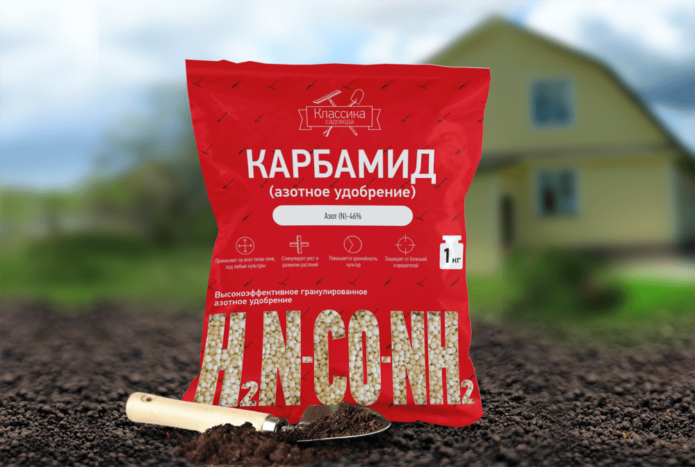
Urea, like other fertilizers with nitrogen content, "wakes up" plants from hibernation, activating growth processes
Blooming Rochefort is watered with fertilizer diluted in water containing nitrogen, potassium and phosphorus (Nitrofosk, Azofosk, Diammofosk). Enough 45-50 g per 10 liters of water. Everything you need is also contained in natural supplements - infusions of cow dung, bird droppings, dandelion leaves, nettle greens. They are cooked for about 3-4 days, filtered before use and diluted with water 1:10 or 1:15 if the raw material was dung. The procedure is repeated two weeks after flowering.
After that, Rochefort no longer needs nitrogen. On the contrary, its excess stimulates the vine to build up green mass, which does not benefit the nutrition of the brushes. It also weakens her immunity.
For the third time, Rochefort is fertilized when the berries reach the size of a hazelnut. In 10 liters of water, dilute with 20-25 g of simple superphosphate and potassium magnesium. A natural source of potassium and phosphorus is wood ash. It can be poured onto the roots while loosening or preparing an infusion. After another three weeks, the plants are watered with a solution of any complex fertilizer for grapes (Novofert, Solution, Florovit, Clean sheet, and so on).
Do not forget about foliar feeding. Once a month, starting in May, the leaves are sprayed with a solution of zinc sulfate, copper sulfate, boric acid, potassium permanganate, ammonium molybdenum (1–2 g per liter of water). The procedure is planned for the evening of a cloudy cool day. To make the solution evaporate more slowly, add half a teaspoon of any vegetable oil or a tablespoon of sugar syrup per liter.
Video: typical mistakes of a beginner winegrower
Pruning
The most difficult procedure, especially for the novice grower. But no matter how difficult it is, it is necessary. A well-formed vine brings a greater yield.
The lion's share of the necessary work is carried out with autumn pruning of grapes on vines with completely fallen leaves at an air temperature not lower than -3 ° C. In spring, only shoots frozen and broken off under the weight of snow are removed. "Wounds" in grapes do not heal in principle, the juice that is released can simply fill the "eyes", provoking the development of rot. For the same reason, pruning is carried out not to the point of growth, but leaving a "stump" 3-4 cm high. It will dry out faster. In summer, you can remove leaves shading the brushes. Chasing is also allowed - shortening the shoots by 10–20 cm.The experience of winegrowers shows that after such a procedure, the quantity and quality of berries increases.
Any trimming is carried out only with a sharply sharpened sterilized instrument. The cuts are done in one continuous motion so as not to loosen the wood. They are immediately disinfected by washing with a 2% solution of copper sulfate. A folk remedy of similar action is sorrel leaf gruel.
The next season, after planting in the ground, the central shoot is cut shortly, leaving two lower buds. Two "sleeves" are grown from them, which are tied horizontally to the lower wire on the trellis. In the fall, one of them is drastically shortened, to the same two buds, the second - to four.
In the second spring, they are returned to the trellis after wintering. New shoots are formed from the growth buds, which are directed vertically at a slight inclination, tying them to the next level wire. The resulting design resembles a fan. In autumn, the first two shoots on the longer "sleeve" are shortened to two buds, on the next four are left. The outer ones should be slightly longer than the inner ones.
A year later, two of the same "sleeves" are formed above the first. Those, in turn, are shortened by half. By this time, they should reach 1–1.5 m in length.
There is no consensus among winegrowers as to when is the best time to prune, in spring or fall. But there are recommendations from experts who claim that autumn pruning is preferable in regions with a harsh climate, and spring pruning in warm climatic zones:https://flowers.bigbadmole.com/en/uhod-za-rasteniyami/obrezka-vinograda-vesnoy.html
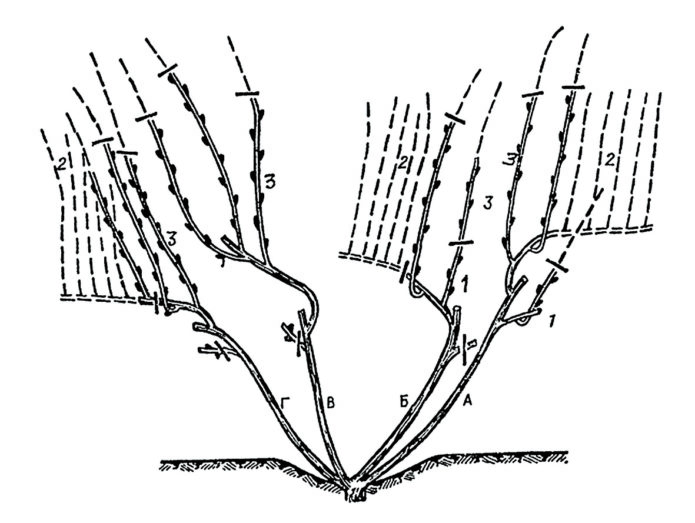
Pruning grapes is a rather complicated procedure for a beginner, but it is absolutely necessary for vines.
The following spring, they get rid of all overgrowth on the trunk below the level of the first wire. The vertical shoots on the “sleeves” are removed, leaving only 2-3 of the top ones. In the fall, they will need to be pinched to the level of the seventh to eighth bud, it is they who will bear fruit. The lower two "sleeves" are cut very short, to the second or third kidney. These will be the so-called replacement knots. Further, the resulting configuration is maintained, annually removing the fruiting vertical shoots. Their place is taken by vines growing from replacement knots.
Video: autumn grape pruning
Preparation for wintering
Rochefort's cold resistance allows him to winter without additional shelter in warm southern regions, but in temperate climates it is absolutely necessary to take care of him. First, you need to clear the near-trunk circle from weeds, fallen leaves, other plant debris, loosen the soil well and renew the mulch layer. Its thickness is at least 10 cm, at the trunk itself - up to 20-25 cm. It is best to use humus or peat chips.
Experienced winegrowers carry out katarovka. They rake the ground a little at the base of the trunk and cut off all the small roots. They will definitely not survive the winter. This procedure will allow the plant not to waste extra food.
Shoots are carefully removed from the trellis, tied up in several pieces and laid out on the ground or placed in shallow grooves dug in advance. From above they are sprinkled with fallen leaves, shavings, covered with spruce branches. If the winter is expected with little snow and harsh, they are additionally covered with two or three layers of burlap or any other material that allows air to pass through.
In spring, the shelter is removed no earlier than the air temperature reaches 10–12 ° C. If recurrent frost is expected, you can first make several holes in it for ventilation.
Video: sheltering vines for the winter
How to deal with typical diseases and pests of the variety
The most dangerous pest for Rochefort grapes is phylloxera.Birds and wasps do not pay special attention to it, but it is still better to play it safe and put small mesh bags on ripening clusters. Or tighten the whole vineyard with it.
Phyloxera (aka grape aphid) are small greenish-yellow insects. It is divided into two varieties - root and leaf. The first is especially difficult to fight. Pests feed on plant juices, attacking the roots or leaves, respectively. They appear on them with swellings of various sizes, resembling warts. The vine stops developing, gradually dries up and dies.
It is almost impossible to notice the appearance of root phylloxera in time. Therefore, in the vast majority of cases, the gardener can only uproot the infected vines and burn them. Grapes cannot be planted in this place and within a radius of 25–30 m for the next 10–15 years.
Practice shows that the pest is repelled by the smell of ordinary parsley. By surrounding the vineyard with a kind of green “barrier”, the risk of phylloxera occurrence can be minimized. You can also add insecticides against the Colorado potato beetle to the water for irrigation (Antizhuk, Bazudin, Zolon). Another reliable way to protect yourself from it is to graft Rochefort cuttings onto a stock that is immune to this pest. But such an operation requires the gardener to have certain skills, and the taste of the berries can change.

To scare off phylloxera, gardeners plant parsley around the perimeter of the vineyard and in the aisles
If leafy phylloxera is noticed in a timely manner, Actellik, Kinmiks, Fozalon, Fustak are used. The same drugs are used for preventive treatments. The vines are sprayed before the leaf buds bloom and twice more with an interval of 2.5–3 weeks.
Video: how to deal with phylloxera on grapes
Oidium or powdery mildew is a fungal disease from which Rochefort grapes suffer most often. The leaves are bent at the edges, covered with a layer of whitish bloom, reminiscent of scattered flour. Gradually it darkens and “thickens”. The buds dry up. On the peel of the berries, a "mesh" of thin strokes appears, turning into cracks, they turn black. They cannot be eaten or used as raw materials for making wine.
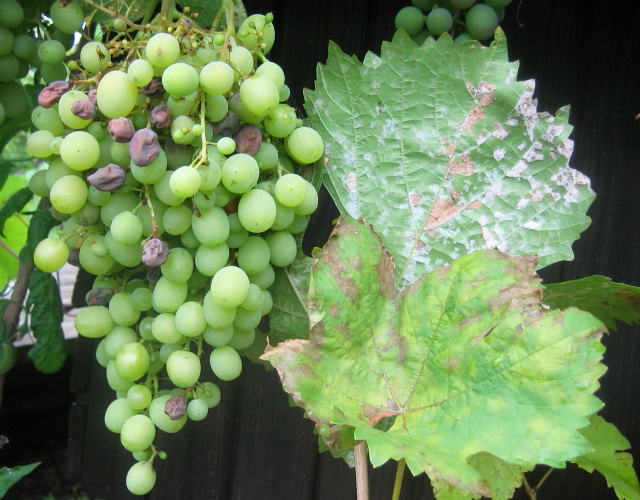
Oidium is a dangerous disease that leads to the loss of most of the crop, and in the long term - of the entire vine, if nothing is done
For prevention, in mid-May, the vines are sprayed with colloidal sulfur (40 g per 10 l of water). It is also used to fight the disease if the fungus is noticed at an early stage, but the concentration of the drug is increased by 2.5 times. Other folk remedies - a solution of soda ash (100 g per 10 liters of water), horsetail rhizomes, garlic shoots. You can also use 3% Nitrafen or 1% Bordeaux liquid. The vineyard is cultivated 4-5 times during the growing season.
In severe cases, fungicides are used. The pathogenic fungus does not tolerate copper compounds. To combat it, both reliable means tested by many generations of gardeners (Bordeaux liquid, copper sulfate) and new modern drugs (Tiovit-Jet, Fitosporin-M, Acrobat-MC, Vitaros) are suitable. But they cannot be sprayed with flowering grapes and vines about a month before the berries ripen.
Gardeners reviews
After visiting the vineyard, my friend liked the Rochefort variety. Decent stability and good marketability of bunches. Has already begun to stain (as of July 18). On my bush, the second growing season - I see good growth strength and stability. Next year I will expect signal fruiting.
Rochefort grapes ... Variety - super: good growth vigor, disease resistance higher than stated.The berry is dense, very large, crispy, with a light nutmeg! The berry on the bush lasts two months. At the moment I have planted 15 bushes.
In our specific conditions in Rochefort, there is no trace of any nutmeg (even after hanging on the bushes for a long time), plus there is a strong pea of berries (like Cardinal's) in each bunch every year. The ripening period is really early, around August 10, but if you wish, you can pinch it earlier, the taste is grassy and the pulp is dense. It stains before it ripens.
For me, Rochefort is delicious. On my land, the Berry of the Lowlands is very similar to the taste of Rochefort, of course, the timing is different ... Everyone who has tried this variety on the site gives a high taste assessment. And what they write: "peas" - it is necessary to work with the bush ... Although I do not have "peas", I will not confirm this fact, it is only the first fruiting.
This form of grapes appeared on our site in the first batch of seedlings from the author and has long been firmly established on the Kuban land. For all these years, I have never regretted that I have these grapes. Maybe because I like the "cardinal" taste of its berries ... The harvest is always stable from the bushes and without peas, which many other growers complain about. But for me it does not mature in any way in the stated 95 days, but somewhere in 105-110 days with a normal load. Bunches easily gain weight of 1 kg or more. I happened to observe on farm plots where Rochefort is grafted on the Kober 5BB rootstock and clusters of 3-4 kg. Berries, depending on the care and age of the bushes, can be up to 20 g, with dense pulp and a slight aftertaste of nutmeg. The grapes themselves are transportable and have a good presentation. Resistance to diseases at the level of 3 points. I want to note one more feature of this grape: the buds open later than everyone else, which has a positive effect on the yield during recurrent frosts.
Rochefort has been living with me for three years already, for me, the taste is simply unique, the bunch is very beautiful, the vine ripens perfectly, there are no problems with diseases with standard treatments, I will increase the number of bushes.
Wasps and sparrows do not touch Rochefort for me. Very good quality for grapes. Yes, and good in terms of yield.
Recently I had a chance to see Rochefort live. Believe me, the photos do not convey the true impression of these berries! Hefty purple balls, great view!
Rochefort is a consistently productive form, it is always well pollinated and the taste is pleasing.
Rochefort is one of my favorite grapes. The strength of growth is great, the berry is large, tasty. The bunches are large.
Most Rochefort growers are unequivocally happy with the purchase. This variety very successfully combines undemanding care with presentability and excellent taste of berries. Also among its undoubted advantages is good immunity. Accordingly, nothing supernatural is required from a gardener who wants to get a crop. But it is better to familiarize yourself with the important nuances of caring for a culture in advance.
